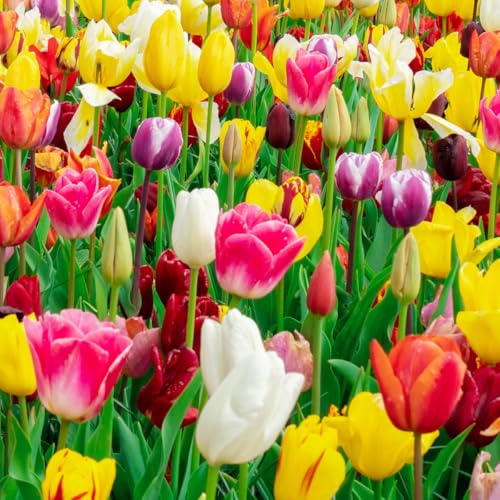Spring is just around the corner, and I can’t wait to see my garden come alive with vibrant colors. Planting bulbs is one of my favorite ways to ensure a stunning display of blooms when the weather warms up.

There’s something magical about digging into the soil and placing those dormant bulbs, knowing they’ll transform your garden into a beautiful paradise. Whether you’re a seasoned gardener or just starting out, planting bulbs for spring blooms is a rewarding and easy way to enhance your outdoor space.
Benefits of Planting Bulbs for Spring Blooms
- Diverse Variety: Featuring hundreds of species such as tulips, daffodils, and crocuses, bulbs offer a wide range of colors and forms.
- Ease of Planting: Requiring minimal preparation and maintenance, bulbs suit both novice and experienced gardeners.
- Cost-Effectiveness: Bulbs are affordable and reusable annually, allowing me to create a vibrant garden without a large investment.
- Extended Blooming Periods: Ensuring continuous color from early to late spring, bulbs maintain the garden’s appeal.
- Low Maintenance: Once planted, bulbs need little care, freeing up my time to enjoy the blooms.
Selecting the Best Bulbs
Choosing the right bulbs ensures robust spring blooms. Consider bulb types and suitable varieties for your garden conditions.
Types of Bulbs
Bulbs fall into two categories: true bulbs and corms.
- True Bulbs: Includes tulips, daffodils, and hyacinths. They have layered scales that store nutrients.
- Corms: Includes crocuses and gladiolus. They consist of solid tissue with a protective tunic.
Each type offers distinct growth patterns and bloom characteristics.
Choosing Suitable Varieties
- Climate: Hardy bulbs like daffodils perform well in cold regions. Amaryllis suit warmer climates.
- Soil Type: Ensure well-drained soil for tulips and crocuses. Opt for bulbs tolerant of clay soils if necessary.
- Sunlight Exposure: Plant sun-loving bulbs such as lilies in full sun areas. Shade-tolerant varieties like snowdrops thrive in partial shade.
- Bloom Time: Combine early, mid, and late bloomers to extend the garden’s display.
Preparing Your Garden for Planting
Getting your garden ready ensures vibrant spring blooms. Proper preparation sets the foundation for healthy bulb growth.
Soil Preparation
I start by assessing the soil type, aiming for well-drained, loamy soil. Mixing in compost enriches the nutrients, promoting strong bulb development. Testing the soil pH helps maintain a range between 6.0 and 7.0, ideal for most spring bulbs. Adding organic matter improves soil structure, enhancing drainage and aeration.
Optimal Planting Time
Planting bulbs in the fall maximizes root establishment before winter. Depending on your climate, this typically occurs 6 to 8 weeks before the first frost date. In warmer regions, late summer provides sufficient time for bulbs to mature. Timing ensures bulbs receive the necessary chill period, leading to robust spring blooms.
Planting Techniques
I use specific techniques to ensure my bulbs thrive and produce vibrant spring blooms. Proper planting sets the foundation for a successful garden.
Depth and Spacing
Planting bulbs at the correct depth and spacing is crucial for their growth and bloom quality.
- Depth: I plant bulbs two to three times their height. For example, a 2-inch tulip bulb goes 4 to 6 inches deep.
- Spacing: I space bulbs about 4 to 6 inches apart to allow room for growth and air circulation.
- Grouping: I cluster bulbs in groups of three to create a natural, fuller look in the garden.
Proper Planting Methods
Using the right planting methods ensures bulbs establish strong roots and bloom beautifully.
- Prepare the Soil: I loosen the soil to a depth of at least 12 inches and mix in compost for added nutrients.
- Position the Bulb: I place each bulb with the pointed end facing upward.
- Backfill and Water: After covering the bulbs with soil, I water the area thoroughly to settle the soil and provide moisture for root development.
- Mulching: I apply a layer of mulch to help retain moisture and protect bulbs from temperature fluctuations.
| Method Step | Description |
|---|---|
| Soil Preparation | Loosen soil, add compost |
| Bulb Positioning | Pointed end up |
| Backfilling & Watering | Cover with soil, water well |
| Mulching | Apply mulch to retain moisture and protect bulbs |
Implementing these techniques helps me achieve a stunning display of spring blooms year after year.
Caring for Blooms After Planting
Maintaining your bulbs after planting ensures they thrive and produce stunning flowers each spring.
Watering and Fertilizing
Consistent watering promotes healthy bulb growth. Aim to water deeply once a week, providing about 1 inch of moisture. During dry spells, increase frequency to twice a week to prevent bulbs from drying out.
Fertilizing supports strong blooms. Apply a balanced, slow-release fertilizer with an N-P-K ratio of 10-10-10 in early spring as shoots emerge. For optimal results, incorporate compost into the soil before planting and topdress with fertilizer midway through the growing season.
Protecting Bulbs from Pests
Prevent bulb damage by controlling common pests. Plant bulbs in well-drained soil to deter rot-causing organisms like fungal gnats. Use raised beds to minimize exposure to pests such as rodents and voles.
Implement physical barriers, like wire mesh, around planting areas to keep larger animals away. Additionally, apply natural repellents, such as garlic or neem oil, to discourage insect infestations without harming beneficial insects.
| Common Pests | Prevention Methods |
|---|---|
| Rodents | Use wire mesh barriers |
| Fungal Gnats | Ensure well-drained soil, avoid overwatering |
| Voles | Plant in raised beds, apply natural repellents |
Regular monitoring and early intervention help maintain a healthy bulb garden, free from unwanted pests.
Top Recommended Bulb Varieties for Spring
Selecting the right bulbs ensures a vibrant spring garden. Here are my top picks for stunning blooms.
« Fertilizing Your Garden: Best Practices for Healthy, Productive Plants Composting Tips for Nutrient-Rich Soil: Boost Your Garden’s Health »
Classic Tulips
I choose tulips for their wide range of colors and elegant shapes. I plant them in well-drained soil, placing each bulb 6 inches deep and spaced 4 inches apart. This setup allows tulips to bloom from early to late spring, providing continuous color.
Daffodils
Daffodils are my go-to for their hardiness and bright hues. I select varieties like ‘King Alfred’ and ‘Thalia’ for their trumpet-shaped and multicolored flowers. Planting these bulbs 8 inches deep promotes strong root growth, ensuring their cheerful blooms brighten the garden.
Hyacinths
Hyacinths stand out with their vibrant colors and delightful fragrance. I plant them in clusters to maximize their visual and aromatic impact. Each bulb goes 4 inches deep and 3 inches apart, allowing hyacinths to flourish and add both beauty and scent to my spring garden.
Common Mistakes to Avoid
Avoiding common errors ensures your spring bulbs thrive and bloom beautifully. Here are the key mistakes to watch out for:
- Planting at Incorrect Depth
Planting bulbs too shallow or too deep can hinder their growth. I ensure each bulb is placed two to three times its height below the soil surface, providing stability and proper root development.
- Choosing Unsuitable Bulb Varieties
Selecting bulbs that don’t match your climate or soil type can lead to poor blooms. I choose varieties like daffodils for colder regions and amaryllis for warmer areas to ensure optimal growth.
- Neglecting Soil Preparation
Poorly prepared soil may lack necessary nutrients and drainage. I enrich the planting bed with compost and verify a pH level between 6.0 and 7.0, creating an ideal environment for bulb roots.
- Planting at the Wrong Time
Planting bulbs too early or too late can disrupt their lifecycle. I plant in the fall, six to eight weeks before the first frost, allowing bulbs to establish roots during the chilling period.
- Overcrowding Bulbs
Crowded bulbs compete for nutrients and space, reducing bloom quality. I space bulbs 4 to 6 inches apart, promoting air circulation and healthy growth.
- Insufficient Watering
Inconsistent watering can prevent bulbs from developing properly. I water deeply once a week and increase frequency during dry spells to maintain adequate moisture levels.
- Ignoring Pest Protection
Pests like rodents and insects can damage bulbs. I protect my garden by using well-drained soil, raised beds, and physical barriers such as wire mesh to keep unwanted visitors at bay.
- Failing to Mulch
Without mulch, bulbs are exposed to temperature fluctuations and moisture loss. I apply a layer of mulch to retain moisture, regulate soil temperature, and protect bulbs through winter.
By steering clear of these mistakes, my spring bulb garden remains vibrant and flourishing each year.
Conclusion
Watching my garden come alive with vibrant blooms each spring brings me so much happiness. Planting bulbs has been a simple yet effective way to create this beautiful transformation.
I love how each new season offers a fresh palette of colors and fragrances. Taking the time to plant and care for bulbs is always worth the stunning display they provide. Here’s to many more years of colorful springs in my garden!
















